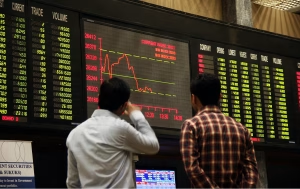Deep within the dynamic world of Forex markets lies the concept of price action trading, a strategy that simplifies the chaos of fluctuating currencies into a form that’s both understandable and actionable for traders. The essence of what is price action in forex trading can be likened to reading the market’s heartbeat, where the price itself narrates the tales of supply and demand. This focused approach sheds the complexity of traditional indicators, serving traders with a clear lens through which the market’s performance can be discerned with precision.
For many, forex price action is not just a method but a philosophy of trading that champions the raw, unadulterated charts as the ultimate source of truth. Here, patterns emerge and speak volumes, offering cues for future market movement. Every dip, rise, and plateau tells a story; making sense of this narrative equips the trader with the foresight needed to maneuver through the volatile sea of currency exchange.
Key Takeaways
- Price action trading focuses on pure price movements for trading decisions, excluding most technical indicators.
- The methodology of price action is grounded in the belief that price reflects all market-affecting factors.
- Patterns within price action are historical indicators that can often suggest future market behavior.
- Understanding price action aids in discerning the market sentiment and predicting potential price trends.
- Price action trading forex strategies require a thorough analysis of price charts, seeking key patterns that inform trade execution.
Understanding Price Action in the Forex Market
Delving into the definition of price action Forex, one must appreciate the essence of price movements and their underpinning values. Known as the heartbeat of the market, price action offers traders a comprehensive perspective by encapsulating market sentiment through pure price changes. As traders adopt the principle of using price action in Forex, they engage in a raw analysis where economic indicators and world news are reflected directly in the price itself, making them part of the strategy rather than stand-alone factors.
The Foundation of Price Movements
At its core, price action trading is predicated on the concept that price is the most reliable and real-time indicator available to traders. By interpreting price data as a direct reflection of market sentiment, traders can begin to predict future market trends. This approach enables a clear and direct analysis of market behavior, allowing traders to make more informed decisions based on the immediate and historical data, thus how to use price action in Forex becomes more intuitive and strategy-centric.
Distilling Market Dynamics to Pure Price Behavior
Price action trading boils down the complex market dynamics to singular focus on price behavior. Without the distractions of secondary indicators, traders concentrate on deciphering the stories told by price movements. Through careful observation of price history and real-time movement, they can unearth valuable clues about future market activity, tapping into a strategic advantage that leverages the distilled essence of market dynamics.
What is Price Action in Forex Trading
Delving into the intricacies of the Forex market, price action stands out as a pivotal concept that empowers traders to make informed decisions. Unlike other trading methods inundated with various technical indicators, price action in Forex trading simplifies the process. It is considered both an art and a science, allowing traders to interpret the market’s dialogue through its most fundamental form — the price itself.
Central to understanding price action is its reliance on a ‘naked’ price chart. This type of chart is virtually devoid of any potential distractions like lagging indicators, which can obfuscate the market’s true voice. Instead, what remains is the raw and unadulterated data of price movements over time. This minimalist approach might occasionally incorporate moving averages, which serve, not as predictive tools, but as reference points for dynamic support and resistance areas.
The goal of this approach is to identify price action signals—specific patterns in price behavior that reveal the continuing saga of supply and demand. These signals can form various recognizable patterns such as triangles, channels, and the classic head and shoulders, providing clues about the market’s underlying sentiment and likely direction. Traders scrutinize these formations, aiming to forecast future price trajectories with a high degree of probability.
By focusing on price patterns, traders are able to harness a powerful form of market analysis to fuel their trading strategy. This technique does not seek to predict market movements per se, but instead to interact with them in a way that can lead to profitable trading opportunities. It embodies the principle that price reflects all relevant information and thus, any emerging trend or turning point is first and foremost reflected in the price action.
- Identification of high-probability trade setups
- Decisions made on succinct, clear chart analysis
- Effective risk management through an understanding of price patterns
In essence, when traders ask “What is price action in forex trading?”, they are inquiring about the skill of interpreting and utilizing the Forex market’s most basic and expressive element — the price. It’s about peeling back the layers of other market noise to reveal the raw and direct communication of buyers and sellers, which is effectively the heart of every financial market.
The Importance of Price Action in Forex
The keen insight provided by price action analysis in the Forex market is irrefutable, particularly for traders who rely on its nuanced interpretation of market fluctuations. It’s a strategy embraced for its direct reflection of market sentiment and facilitator of nimble, well-informed decisions. Below, we explore how price action forms the bedrock for understanding market dynamics and future price directions.
Interpreting Market Sentiment Through Price
Traders often consider the importance of price action in forex as it serves as a real-time barometer of collective trader sentiment. By studying price movements, investors can glean greater understanding of the market without the lag associated with conventional indicators. This immediacy enables a pure representation of market behavior and trader psychology, forming the basis for sound trade entry and exit points.
Price Action as a Predictor of Future Movements
One of the notable benefits of price action in forex trading is its predictive power, founded on the premise that historical price patterns tend to repeat themselves. Skilled traders analyze these patterns, recognizing the signs that precedent market conditions may resurface, therewith providing anticipatory insight into potential price movement trajectories.
| Characteristic | Price Action Trading | Indicator-Based Trading |
|---|---|---|
| Focus | Current and historical price data | Mathematical calculations of past data |
| Benefits | Real-time market sentiment; High-probability forecasting | Clear signal generation; Automated analysis |
| Timeframe Relevance | Effective across various timeframes | May require optimization for different timeframes |
| Decision-Making | Based on current price and historical patterns | Dependent on the output from selected indicators |
The clear contrasts in the table underscore why many traders favor price action over traditional indicators. By prioritizing direct price data, traders exploit the immediate and unpolluted perspective of market conditions that price action offers—a crucial aspect for consistent success in the fluctuating forex landscape.
Recognizing Price Action Patterns
In the realm of Forex trading, the ability to decipher price action patterns stands as a critical skill for seeking profitable transaction points. Seasoned traders integrate price action strategies forex methodologies to gain a competitive advantage in the market. Emphasizing the use of these patterns aids in pinpointing precise moments to enter or exit a trade, based on the narratives spun by price movements themselves.
Identifying Bullish and Bearish Setups
Familiarity with bullish and bearish setups is paramount in leveraging market trends. These setups offer visual cues that allow traders to align with market momentum. For instance, a bullish engulfing pattern on a support level might provide the green light to consider a long position. Conversely, a bearish pattern emerging at resistance could suggest preparation for a potential downward trajectory. The acumen in discerning these environments is enhanced by the inclusion of a price action indicator forex model, which can bolster confirmation of the anticipated price shifts.
The Significance of Candlestick Formations
Candlestick formations are the building blocks of price action analysis, signaling the markets’ sentiments. Particular attention is paid to individual candles and clusters that suggest imminent changes. Let’s scrutinize two prevalent structures:
- Pin Bars: Denoting rejections of higher or lower prices, implying a sharp reversal in sentiment.
- Engulfing Patterns: Highlighting a complete overtaking of the previous candle’s range, often marking the commencement of a trend reversal.
Candlestick setups are to Forex trading what punctuation is to sentences; they provide context, denote pauses in market sentiment, and emphasize potential shifts. Understanding the subtleties of such configurations can vastly impact the effectiveness of a trader’s market participation.
| Pattern Type | Description | Typical Response |
|---|---|---|
| Bullish Pin Bar | A single candle with a small body and long lower wick, rejecting lower prices. | Consider long positions near the tail’s rebound with stop loss below it. |
| Bearish Pin Bar | A single candle with a small body and long upper wick, rejecting higher prices. | Contemplate short positions near the tail’s capitulation with stop loss above it. |
| Bullish Engulfing | A pattern where a large bullish candle completely engulfs the previous bearish one. | Initiate long positions following the engulfing candle with a stop loss beneath it. |
| Bearish Engulfing | A pattern where a large bearish candle entirely consumes the previous bullish one. | Engage in short positions subsequent to the engulfing candle with a stop loss above it. |
As the narrative of the Forex market unfolds, adept traders harness these patterns for crafting tales of opportunity, orchestrating their trades with precision amidst the constant ebb and flow of global currencies.
The Role of Technical Indicators in Price Action Trading
While price action trading forex purists may frown upon the use of technical indicators, it’s undeniable that they can serve as valuable tools when used sparingly and with purpose. In the realm of forex price action, certain indicators have gained acceptance among traders for their ability to enhance, rather than distract, from the key task of price trend analysis.
The judicious application of moving averages is one such example of this complementary relationship. A simple moving average (SMA) or an exponential moving average (EMA) can provide visual confirmation of trend direction and momentum, while also highlighting dynamic levels of support and resistance. However, it’s crucial that traders do not lose sight of the primary directive of price action strategy: to interpret the market through price movements themselves.
- Moving Averages: Simple tools to determine market trends and validate price action insights.
- Fibonacci Retracements: Often utilized to predict potential levels of support and resistance within major price movements.
- Volume: An indicator of the strength behind price movements, aiding in confirming the authenticity of a breakout or reversal.
The table below outlines common technical indicators that may be used by price action traders, each playing a specific role that complements pure price analysis:
| Technical Indicator | Role in Price Action Trading | How It Complements Price Action |
|---|---|---|
| Moving Averages (SMA & EMA) | Trend Confirmation | Visually confirms the direction and strength of the market trend. |
| Fibonacci Retracement | Support/Resistance Analysis | Provides a framework for potential price reversal points. |
| Volume | Price Movement Validation | Corroborates the significance of price breakouts or collapses. |
By integrating these indicators with a foundation of price action analysis, forex traders can refine their decision-making process. Nevertheless, the key is moderation; the objective is not to clutter the chart with indicators but to employ them to reinforce the insights gained from studying price action.
Ultimately, it is the understanding of pure price movements that will empower traders in the forex price action arena. When used correctly, technical indicators are not the stars of the show, but rather the supporting cast that can subtly guide traders towards more informed and confident trading decisions in the complex world of price action trading forex.
Strategies for Trading with Price Action
When it comes to navigating the dynamic realm of the Forex market, employing price action strategies forex can provide robust insights and improve trade decision-making. These strategies focus on the pure analysis of price movements without being overshadowed by complex indicators.
Employing Support and Resistance with Price Action
Understanding and how to use price action in forex trading starts with the fundamental concept of support and resistance. These two elements are pillars in the market structure, representing key price levels where the market has historically shown to pause or reverse. Support acts as a floor where price tends to bounce upward, while resistance works as a ceiling where prices typically deflect downward.
Confluence in Price Action Signals
Traders often wait for moments of confluence – the alignment of several price action signals – to confirm their trades. This could mean a simultaneous occurrence of support and resistance levels with pin bar formations, for instance. Such confluence reinforces the validity of a potential entry point, enhancing the trader’s confidence in the execution of the trade.
Using Trends to Inform Price Action Decisions
Identifying the market’s trend is vital in price action strategies forex. By observing higher highs and lows in an uptrend or lower highs and lows in a downtrend, traders can deduce the market’s momentum. With this insight, they can better anticipate potential swing points in price, making it easier to detect trend reversals or continuations.
Price action strategies are about simplicity and clarity. They facilitate a trading environment where decisions are informed by price movements and market dynamics, stripped of unnecessary noise from overcomplicated indicators. Mastery of these techniques opens the door to more informed and potentially profitable trading behavior in the Forex market.
Price Action Trends and Market Analysis
In the realm of price action trading forex, a trader’s ability to differentiate between trending and consolidating markets is vital for interpreting movements within the forex price action landscape. Distinct trends offer the backbone for in-depth market analysis, where strategic decisions are based on observed patterns and the recurring nature of price behaviors.
Distinguishing Between Trending and Consolidating Markets
The concept of trending markets in Forex is characterized by a sequence of higher highs and lows for an uptrend, or a series of lower highs and lows for a downtrend, indicative of a market poised for continued momentum in a specific direction. A price action indicator forex can be instrumental in monitoring these trends, aiding traders in establishing their market positions accordingly.
Conversely, a consolidating market is evidenced by price movement that meanders laterally, creating a range-bound environment. Such phases of consolidation suggest market indecision, yet they can accrue substantial opportunities for experienced range traders who know how to capitalize on this price stability.
Correlating Price Action with Market Phases
Understanding the relationship between price action and market phases is crucial for developing comprehensive forex price action strategies. Through keen observation and analysis of price action, traders can correlate specific price behaviors with the phases of market trends or periods of consolidation.
| Market Phase | Trend Indicators | Consolidation Indicators | Potential Price Action Strategy |
|---|---|---|---|
| Uptrend | Higher highs and lows | Flat tops, equal lows | Buy on dips within the trend |
| Downtrend | Lower highs and lows | Equal highs, flat bottoms | Sell on rallies within the trend |
| Consolidation | Reduced volume, narrowed range | Horizontal channel formation | Trade breakouts or range boundaries |
This systematic approach provides a structured methodology for traders as they apply price action trading forex techniques to navigate through the ever-evolving Forex markets.
Benefits of Price Action in Forex Trading
Traders across the globe recognize the importance of price action in forex for its ability to distill the complexities of market dynamics into pure and intelligible insights. Embracing this method infuses clarity into trading strategies, engendering a robust understanding of market forces without the encumbrance of multiple indicators.
Simplicity and Minimality in Analysis
The minimalistic philosophy integral to price action trading unveils the benefits of price action in forex trading through its uncomplicated nature. By shedding the often confusing and conflicting signals of technical indicators, traders gain access to the market’s narrative in its most unadulterated form. This approach prioritizes a crisp and clear analysis, which provides a coherent vantage point from which decisive trading moves can be planned and executed.
Enhanced Interpretation of Market Information
Moreover, the importance of raw price data is evidenced in the way it refines a trader’s ability to interpret market information. Staring directly into the heart of the market’s price action, practitioners can pinpoint the equilibrium between supply and demand with greater precision. This direct engagement with price data often leads to heightened responsiveness in a shifting market, and a marked reduction in over-trading, which is a common hazard for those entangled in overly complex analytical methods.
How to Use Price Action in Forex
Mastering the art of price action in forex trading can significantly enhance your market analysis and decision-making process. It demands an uncluttered approach, typically involving the study of ‘naked’ charts that solely reflect price movements. Such visual simplicity aids in focusing on interpreting pure price data without the distraction of too many indicators. Let’s delve into how you can set up your charts for this strategy and identify trades that offer heightened probabilities of success.
Setting Up Naked Charts for Analysis
To adeptly use price action in forex, commence by purifying your chart setup. This entails the elimination of all superfluous indicators that could muddle your view of price movements. By maintaining clean and simple charts, you focus solely on the price, which acts as the most up-to-date reflection of market sentiment. Watching how the price ebbs and flows naturally, without the distraction of lagging indicators, allows for a more in-depth appreciation of market dynamics and trader psychology.
Identifying High-Probability Trades
Within the realm of price action strategies forex traders employ, identifying trades with a strong likelihood of profitability is paramount. This involves comprehensive analysis of historical price action to inform predictions of forthcoming trends and movements. Seek significant price levels and observe market momentum to pinpoint optimal entry and exit points. Moreover, candlestick patterns like pin bars or engulfing bars provide actionable insights. These trading setups become more compelling when they align with the prevailing market trend and are supported by solid support and resistance zones, thereby enriching the overall strategy with a robust risk-reward ratio.










